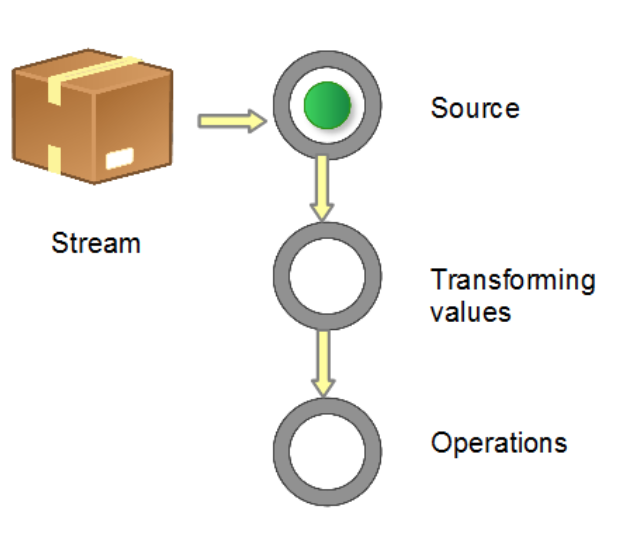前言
Java8中提供了Stream对集合操作作出了极大的简化,学习了Stream之后,我们以后不用使用for循环就能对集合作出很好的操作。
本文将给大家详细介绍关于java8 Stream使用的相关内容,下面话不多说了,来一起看看详细的介绍吧
1. 原理
Stream 不是集合元素,它不是数据结构并不保存数据,它是有关算法和计算的,它更像一个高级版本的 Iterator。
原始版本的 Iterator,用户只能显式地一个一个遍历元素并对其执行某些操作;
高级版本的 Stream,用户只要给出需要对其包含的元素执行什么操作,比如:
Stream 就如同一个迭代器(Iterator),单向,不可往复,数据只能遍历一次,遍历过一次后即用尽了,就好比流水从面前流过,一去不复返。
而和迭代器又不同的是,Stream 可以并行化操作
Stream 的另外一大特点是,数据源本身可以是无限的
2.使用步骤
获取一个数据源(source)→ 数据转换→执行操作获取想要的结果
每次转换原有 Stream 对象不改变,返回一个新的 Stream对象(可以有多次转换),这就允许对其操作可以像链条一样排列,变成一个管道,如下图所示。

3. Stream的构造
public void test4() {
Stream stream = Stream.of("a", "b", "c", 23);
stream.forEach(key -> System.out.println(key));
String[] array = new String[]{"abc", "efg"};
stream = Stream.of(array);
stream = Arrays.stream(array);
stream.forEach(key -> System.out.println(key));
List<String> list = Arrays.asList(array);
stream = list.stream();
//IntStream、LongStream、DoubleStream
IntStream stream2 = IntStream.of(1, 2, 3, 3);
DoubleStream stream4 = DoubleStream.of(1, 2, 3, 3.4);
stream2.forEach(key -> System.out.println(key));
stream4.forEach(key -> System.out.println(key));
}
结果
a
b
c
23
abc
efg
1
2
3
3
1.0
2.0
3.0
4. Stream的转换
public void test6() {
Stream stream = Stream.of("abc", "def");
String[] array = (String[])stream.toArray(String[]::new);
System.out.println(array.length);
List<String> list = (List<String>)Stream.of("1", "2", "3").collect(Collectors.toList());
String str = Stream.of("abc", "mn").collect(Collectors.joining()).toString();
System.out.println(array);
System.out.println(list);
System.out.println(str);
}
结果
2
[Ljava.lang.String;@17f052a3
[1, 2, 3]
abcmn
5.一个 Stream 只可以使用一次
public void test6_5() {
Stream stream = Stream.of(1, 2, 3, 2);
System.out.println("count:" + stream.count());
System.out.println("count:" + stream.count());
}
输出
Exception in thread "main" java.lang.IllegalStateException: stream has already been operated upon or closed
at java.util.stream.AbstractPipeline.<init>(AbstractPipeline.java:203)
at java.util.stream.LongPipeline.<init>(LongPipeline.java:91)
at java.util.stream.LongPipeline$StatelessOp.<init>(LongPipeline.java:572)
at java.util.stream.ReferencePipeline$5.<init>(ReferencePipeline.java:221)
at java.util.stream.ReferencePipeline.mapToLong(ReferencePipeline.java:220)
at java.util.stream.ReferencePipeline.count(ReferencePipeline.java:526)
at streamTest.StreamTest.test6_5(StreamTest.java:68)
at streamTest.StreamTest.main(StreamTest.java:181)
count:4
6.转换大写
public void test7() {
List<String> list = Arrays.asList("a", "MnM");
List<String> result = list.stream().
map(String::toUpperCase).
collect(Collectors.toList());
System.out.println(list);
System.out.println(result);
}
输出
[a, MnM]
[A, MNM]
7.平方
public void test8() {
List<Integer> list2 = Arrays.asList(1, 2, 4);
List<Integer> list3 = list2.stream().
map(key -> key * key).
collect(Collectors.toList());
System.out.println(list2);
System.out.println(list3);
}
输出
[1, 2, 4]
[1, 4, 16]
8.找偶数
public void test8_5() {
List<Integer> list2 = Arrays.asList(1, 2, 4);
List<Integer> list3 = list2.stream().
filter(key -> key % 2 == 0).
collect(Collectors.toList());
System.out.println(list2);
System.out.println(list3);
}
输出
[1, 2, 4]
[2, 4]
9. 区间值
public void test5() {
System.out.println("\n");
IntStream.range(1, 3).forEach(System.out::println);
System.out.println("\n");
IntStream.rangeClosed(1, 3).forEach(System.out::println);
}
结果
1
2
1
2
3
10.并发
public void test5_pa() {
IntStream.rangeClosed(1, 10).parallel().forEach(System.out::println);
}
输出
3
7
1
5
2
8
10
6
9
4
是否并发思考
11. 新的Stream继续操作
public void test6_6() {
Stream.of("one", "two", "three", "four")
.filter(e -> e.length() > 3)
.peek(e -> System.out.println("Filtered value: " + e))
.map(String::toUpperCase)
.peek(e -> System.out.println("Mapped value: " + e))
.collect(Collectors.toList());
}
结果
Filtered value: three
Mapped value: THREE
Filtered value: four
Mapped value: FOUR
12. Optional
public static void print(String text) {
System.out.println("<<<<<<");
System.out.println(Optional.ofNullable(text));
List<String> obj = new ArrayList<>();
Optional.ofNullable(text).ifPresent(System.out::println);
System.out.println(">>>>>>>>>>>>\n");
}
public static int getLength(String text) {
return Optional.ofNullable(text).map(String::length).orElse(-1);
}
public void test14() {
String strA = " abcd ", strB = null;
print(strA);
print("");
print(strB);
System.out.println(getLength(strA));
System.out.println(getLength(""));
System.out.println(getLength(strB));
}
结果
<<<<<<
Optional[ abcd ]
abcd
>>>>>>>>>>>>
<<<<<<
Optional[]
>>>>>>>>>>>>
<<<<<<
Optional.empty
>>>>>>>>>>>>
6
0
-1
13. 字符串拼接、最值、求和、过滤
public void test15() {
String concat = Stream.of("A", "B", "C").reduce("", String::concat);
System.out.println("concat:" + concat);
double minValue = Stream.of(-1.5, 1.0, -3.0, -2.0).reduce(Double.MAX_VALUE, Double::min);
System.out.println("min:" + minValue);
int sumValue = Stream.of(1, 2, 3, 4).reduce(0, Integer::sum);
System.out.println("sum1:" + sumValue);
int sumValue2 = Stream.of(1, 2, 3, 4).reduce(Integer::sum).get();
System.out.println("sum2:" + sumValue2);
concat = Stream.of("a", "B", "c", "D", "e", "F").filter(x -> x.compareTo("Z") > 0).reduce("", String::concat);
System.out.println("concat:" + concat);
}
结果
concat:ABC
min:-3.0
sum1:10
sum2:10
concat:ace
14. limit, skip
public void test16() {
List<Person> persons = new ArrayList<>();
IntStream.range(1, 1000).forEach(key->persons.add(new Person(key, "jihite:" + key)));
List<String> personList = persons.stream().map(Person::getName).limit(10).skip(3).collect(Collectors.toList());
System.out.println(personList);
}
输出
[jihite:4, jihite:5, jihite:6, jihite:7, jihite:8, jihite:9, jihite:10]
15.找出最长一行的长度
public void test19() throws IOException {
String path = "**/Person.java";
BufferedReader br = new BufferedReader(new FileReader(path));
int longest = br.lines()
.mapToInt(String::length)
.max()
.getAsInt();
br.close();
System.out.println(longest);
}
输出
16.找出全文的单词,转小写,并排序
public void test20() throws IOException {
String path = "**/Person.java";
BufferedReader br = new BufferedReader(new FileReader(path));
List<String> words = br.lines()
.flatMap(line->Stream.of(line.split(" ")))
.filter(word->word.length()>0)
.map(String::toLowerCase)
.distinct()
.sorted()
.collect(Collectors.toList());
br.close();
System.out.println(words);
words.forEach(key-> System.out.println(key));
}
输出
*
*/
/**
//
2018/10/24
21:40
=
@author:
@date:
@description:
class
getname()
int
name)
参考
Java 8 中的 Streams API 详解
总结
以上就是这篇文章的全部内容了,希望本文的内容对大家的学习或者工作具有一定的参考学习价值,如果有疑问大家可以留言交流,谢谢大家对亿速云的支持。
免责声明:本站发布的内容(图片、视频和文字)以原创、转载和分享为主,文章观点不代表本网站立场,如果涉及侵权请联系站长邮箱:is@yisu.com进行举报,并提供相关证据,一经查实,将立刻删除涉嫌侵权内容。